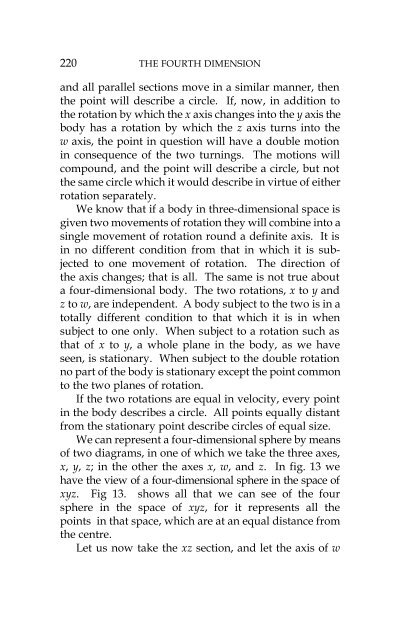Create successful ePaper yourself
Turn your PDF publications into a flip-book with our unique Google optimized e-Paper software.
220<br />
THE FOURTH DIMENSION<br />
and all parallel sections move in a similar manner, then<br />
the point will describe a circle. If, now, in addition to<br />
the rotation by which the x axis changes into the y axis the<br />
body has a rotation by which the z axis turns into the<br />
w axis, the point in question will have a double motion<br />
in consequence of the two turnings. <strong>The</strong> motions will<br />
compound, and the point will describe a circle, but not<br />
the same circle which it would describe in virtue of either<br />
rotation separately.<br />
We know that if a body in three-dimensional space is<br />
given two movements of rotation they will combine into a<br />
single movement of rotation round a definite axis. It is<br />
in no different condition from that in which it is subjected<br />
to one movement of rotation. <strong>The</strong> direction of<br />
the axis changes; that is all. <strong>The</strong> same is not true about<br />
a four-dimensional body. <strong>The</strong> two rotations, x to y and<br />
z to w, are independent. A body subject to the two is in a<br />
totally different condition to that which it is in when<br />
subject to one only. When subject to a rotation such as<br />
that of x to y, a whole plane in the body, as we have<br />
seen, is stationary. When subject to the double rotation<br />
no part of the body is stationary except the point common<br />
to the two planes of rotation.<br />
If the two rotations are equal in velocity, every point<br />
in the body describes a circle. All points equally distant<br />
from the stationary point describe circles of equal size.<br />
We can represent a four-dimensional sphere by means<br />
of two diagrams, in one of which we take the three axes,<br />
x, y, z; in the other the axes x, w, and z. In fig. 13 we<br />
have the view of a four-dimensional sphere in the space of<br />
xyz. Fig 13. shows all that we can see of the four<br />
sphere in the space of xyz, for it represents all the<br />
points in that space, which are at an equal distance from<br />
the centre.<br />
Let us now take the xz section, and let the axis of w






![[PDF] Prolegomena](https://img.yumpu.com/16774951/1/190x245/pdf-prolegomena.jpg?quality=85)









